| The capitulation of the state of Japan to the conditions provided by the Allies | |
|---|---|
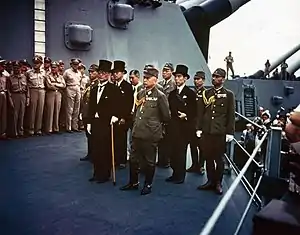 Representatives of the Empire of Japan stand aboard USS Missouri prior to signing of the Instrument of Surrender. | |
| Type | Capitulation |
| Signed | 2 September 1945 |
| Location | Tokyo Bay, Japan |
| Condition | Signed |
| Parties | |
| Ratifiers | Allied Governments |
| Full text | |
The Japanese Instrument of Surrender was the written agreement that formalized the surrender of the Empire of Japan, marking the end of hostilities in World War II. It was signed by representatives from the Empire of Japan and from the Allied nations: the United States of America, the Republic of China,[note 1] the United Kingdom of Great Britain and Northern Ireland, the Union of Soviet Socialist Republics, the Commonwealth of Australia, the Dominion of Canada, the Provisional Government of the French Republic, the Kingdom of the Netherlands, and the Dominion of New Zealand. The signing took place on the deck of USS Missouri in Tokyo Bay on 2 September 1945.
The date is sometimes known as Victory over Japan Day. However, that designation more frequently refers to the date of Emperor Hirohito's Gyokuon-hōsō (Imperial Rescript of Surrender), the radio broadcast announcement of the acceptance of the terms of the Potsdam Declaration at noon Japan Standard Time on 15 August.
Preparation
General Douglas MacArthur's staff, headed by Colonel LeGrande A. Diller, were tasked to prepare the draft of the Instrument of Surrender. This was a challenge given resources were limited in war-torn Manila. Nevertheless, an enterprising staff member found rare parchment in a basement of a monastery, and this was given to MacArthur's printer.[1]
Surrender ceremony

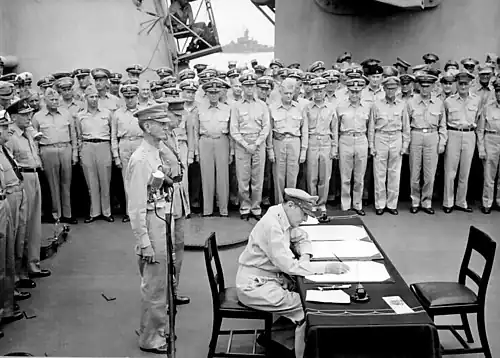
The ceremony aboard the deck of Missouri lasted 23 minutes and was broadcast throughout the world. It occurred at 35°21′17″N 139°45′36″E / 35.3547°N 139.76°E in Tokyo Bay. The instrument was first signed by the Japanese foreign minister Mamoru Shigemitsu "By Command and on behalf of the Emperor of Japan and the Japanese Government" (9:04 a.m.).[2] General Yoshijirō Umezu, Chief of the Army General Staff, then signed the document "By Command and on behalf of the Japanese Imperial General Headquarters" (9:06 a.m.).[2][3] The Japanese representatives present for the signing were the following:
- Foreign Minister Mamoru Shigemitsu[4]
- General Yoshijirō Umezu, Chief of the Army General Staff[4]
- Major General Yatsuji Nagai[4]
- Katsuo Okazaki (Foreign Ministry)[4]
- Rear Admiral Tadatoshi Tomioka[4]
- Toshikazu Kase (Foreign Ministry)[4]
- Lt. General Suichi Miyakazi[4]
- Rear Admiral Ichiro Yokoyama[4]
- Saburo Ota (Foreign Ministry)[4]
- Captain Katsuo Shiba (Navy)[4]
- Colonel Kaziyi Sugita[4]
At 9:08 a.m., American General of the Army Douglas MacArthur, the Commander in the Southwest Pacific and Supreme Commander for the Allied Powers, accepted the surrender on behalf of the Allied Powers and signed in his capacity as Supreme Commander.[5]
After MacArthur, the following representatives signed the instrument of surrender on behalf of each of the Allied Powers:
- Fleet Admiral Chester Nimitz for the United States (9:12 a.m.)[2][6]
- General Hsu Yung-chang for China (9:13 a.m.)[2][7]
- Admiral Sir Bruce Fraser for the United Kingdom (9:14 a.m.)[2][8]
- Lieutenant General Kuzma Derevyanko for the Soviet Union (9:16 a.m.)[2][9][note 2]
- General Sir Thomas Blamey for Australia (9:17 a.m.)[2][10]
- Colonel Lawrence Moore Cosgrave for Canada (9:18 a.m.)[2][11]
- Général de Corps d'Armée Philippe Leclerc de Hauteclocque for France (9:20 a.m.)[2][12]
- Lieutenant Admiral Conrad Helfrich for the Netherlands (9:21 a.m.)[2][13]
- Air Vice-Marshal Leonard M. Isitt for New Zealand (9:22 a.m.)[2][14]
The UK invited Dominion governments to send representatives to the ceremony as subordinates to its own. MacArthur supported the government of Australia's demand to attend and sign separately from the UK, although Australia objected to his recommendation that Canada, the Netherlands, and France also sign the document.[15]
On 6 September, Colonel Bernard Theilen took the document and an imperial rescript to Washington, D.C., and presented them to President Harry S. Truman in a formal White House ceremony the following day. The documents were then exhibited at the National Archives.[16]
Flags at the ceremony
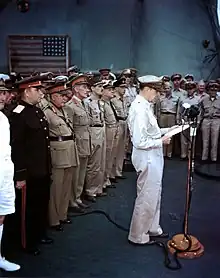
The deck of the Missouri was furnished with two American flags. A commonly heard story is that one of the flags had flown over the White House on the day Pearl Harbor was attacked. However, Captain Stuart Murray of USS Missouri explained:
At eight o'clock we had hoisted a clean set of colors at the mainmast and a clean Jack of the United States at the bow as we were at anchor, and I would like to add that these were just regular ship's flags, GI issue, that we'd pulled out of the spares, nothing special about them, and they had never been used anywhere so far as we know, at least they were clean and we had probably gotten them in Guam in May. So there was nothing special about them. Some of the articles in the history say this was the same flag that was flown on the White House or the National Capitol on 7 December 1941, the attack on Pearl Harbor, and at Casablanca, and so forth, also MacArthur took it up to Tokyo and flew it over his headquarters there. The only thing I can say is they were hard up for baloney, because it was nothing like that. It was just a plain ordinary GI-issue flag and a Union Jack. We turned them both into the Naval Academy Museum when we got back to the East Coast in October. The only special flag that was there was a flag which Commodore Perry had flown on his ship out in that same location 82 years before [sic, recte 92]. It was flown out in its glass case from the Naval Academy Museum. An officer messenger brought it out. We put this hanging over the door of my cabin, facing forward, on the surrender deck so that everyone on the surrender deck could see it.[17]
That special flag on the veranda deck of the Missouri had been flown from Commodore Matthew Perry's flagship in 1853–54 when he led the U.S. Navy's Far East Squadron into Tokyo Bay to force the opening of Japan's ports to foreign trade. MacArthur was a direct descendant of the New England Perry family and cousin of Commodore Matthew Perry.
Photographs of the signing ceremony show that this flag is displayed backward — reverse side showing (stars in the upper right corner). This was because American flags on the right of an object plane, ship, or person have the stars on the upper right corner, to look like the flag is heading into battle — as if attached to a pole and someone is carrying it. Stars in the upper left of a flag displayed on the right side of the object could make the flag look like it were going away from battle. The cloth of the historic flag was so fragile that the conservator at the U.S. Naval Academy Museum directed that a protective backing be sewn on it, leaving its "wrong side" visible; and this was how Perry's 31-star flag was presented on this unique occasion.[18]
A replica of this historic flag can be seen today on the Surrender Deck of the Battleship Missouri Memorial in Pearl Harbor.[18] This replica is also placed in the same location on the bulkhead of the veranda deck where it had been initially mounted on the morning of 2 September 1945, by Chief Carpenter Fred Miletich.[2] The original flag is still on display at the Naval Academy Museum, as is the table and tablecloth upon which the instrument of surrender was signed, and the original bronze plaque marking the location of the signing (which was replaced by two replicas in 1990). However, it is not certain that the table is the actual one used as the deck had been cleaned and items returned to storage before anyone thought to save it.
Differences between versions
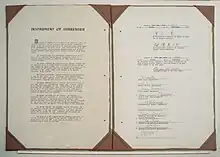
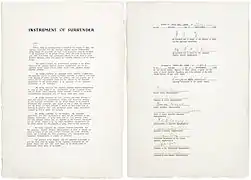
The Japanese copy of the treaty varied from the Allied in the following ways:
- The Allied copy was presented in leather and gold lining with both countries' seals printed on the front, whereas the Japanese copy was bound in rough canvas with no seals on the front.
- The Canadian representative, Colonel Lawrence Moore Cosgrave, signed below his line instead of above it on the Japanese copy, so everyone after him had to sign one line below the intended one. This was attributed to Cosgrave being blind in one eye from a World War I injury. When the discrepancy was pointed out to General Sutherland, he crossed out the pre-printed name titles of the Allied nations and rewrote by hand the titles in their correct relative positions. The Japanese initially found this alteration unacceptable—until Sutherland initialed (as an abbreviated signature) each alteration. The Japanese representatives did not complain further.[19]
Current locations
The Allied copy of the Instrument is at the United States National Archives Building in Washington, D.C.[20] The Japanese copy is at the Diplomatic Archives of the Ministry of Foreign Affairs of Japan in Tokyo, and was last publicly displayed in 2015, as part of an exhibition marking the 70th anniversary of the signing. A replica version of the Japanese copy can be viewed at the archive's gallery, and at the Edo-Tokyo Museum in Tokyo.[21]
Gen. MacArthur originally had 11 full-sized facsimiles made of the Instrument of Surrender, but later increased this for distribution among the Allied nations present during the signing. Two of the copies which were given to Col. LeGrande A. Diller and MGen. Basilio Valdes for the Philippines are now displayed at The International Museum of World War II in Natick, Massachusetts.[22]
As witnesses, American general Jonathan Wainwright, who had surrendered the Philippines, and British lieutenant-general Arthur Percival, who had surrendered Singapore, received two of the six pens used by General MacArthur to sign the instrument. Another pen went to the West Point military academy, and one to MacArthur's aide. All of the pens used by MacArthur were black, except the last, which was bright red and went to his wife.[23] A replica of it, along with copies of the instrument of surrender, is in a case on Missouri by the plaque marking the signing spot. The model of USS Missouri in the National Museum of the United States Navy at the Washington Navy Yard, has a scale replica of the signing table in the correct location.
The National History Museum of the Republic of China has a reprint, and the Instrument of Surrender (along with seven other historic documents) was designated as a "National Treasure" by the Ministry of Culture of the Republic of China in 2016.[24][25][26]
Gallery
 Ships of U.S. Third Fleet and British Pacific Fleet in Sagami Wan, 28 August 1945, preparing for the formal Japanese surrender. Nearest ship is USS Missouri. HMS Duke of York is just beyond, with HMS King George V further in. USS Colorado is in far center distance. Mount Fuji is in the background.
Ships of U.S. Third Fleet and British Pacific Fleet in Sagami Wan, 28 August 1945, preparing for the formal Japanese surrender. Nearest ship is USS Missouri. HMS Duke of York is just beyond, with HMS King George V further in. USS Colorado is in far center distance. Mount Fuji is in the background. Lieutenant General Richard K. Sutherland, aboard USS Missouri, corrects a signatory error in the Japanese Instrument of Surrender. US Colonel Sidney Mashbir and Japanese Foreign Minister Katsuo Okazaki look on.
Lieutenant General Richard K. Sutherland, aboard USS Missouri, corrects a signatory error in the Japanese Instrument of Surrender. US Colonel Sidney Mashbir and Japanese Foreign Minister Katsuo Okazaki look on. Plaque over the door to the Captain's Cabin on board the Missouri marking the signing
Plaque over the door to the Captain's Cabin on board the Missouri marking the signing.jpg.webp) Plaque in the deck of the Missouri marking the location of the signing
Plaque in the deck of the Missouri marking the location of the signing_flyover%252C_Tokyo_Bay%252C_2_September_1945_(520775).jpg.webp) Huge formation of American planes over USS Missouri and Tokyo Bay celebrating the signing, 2 September 1945
Huge formation of American planes over USS Missouri and Tokyo Bay celebrating the signing, 2 September 1945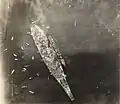 Photo taken from an airplane flying over USS Missouri. USS Buchanan is alongside.
Photo taken from an airplane flying over USS Missouri. USS Buchanan is alongside.
See also
- Cairo Declaration (1943)
- General Order No. 1 (Aug. 1945)
- Retrocession Day (Oct. 1945)
- List of Allied ships at the Japanese surrender
Post-war
Other Axis
Notes
- ↑ The Republic of China was the only government of China until the People's Republic of China was promulgated in 1949.
- ↑ The Soviet Union had only declared war on Japan a month earlier, after the Hiroshima bombing.
References
- ↑ "Video Transcript of Japan Signs Final Surrender – 1945" (PDF). The National Archives. National Archives and Records Administration.
- 1 2 3 4 5 6 7 8 9 10 11 12 Broom, Jack (May 21, 1998). "Memories on Board Battleship". Seattle Times.
- ↑ photo at AWM of Umezu signing. Archived 2008-10-05 at the Wayback Machine
- 1 2 3 4 5 6 7 8 9 10 11 "USS Missouri BB-63; Japanese Surrender Sept. 2, 1945; Page 3: The Japanese delegation aboard the USS Missouri BB-63 (second photo on this webpage)". MaritimeQuest.com.
- ↑ Prepared by the War Department. Approved by President Truman (1945). Japanese Instrument of Surrender [scan]
 .
. - ↑ photo at AWM, Nimitz signing. Archived 2012-09-08 at the Wayback Machine
- ↑ AWM photo, Hsu Yung-chang signing. Archived 2012-09-08 at the Wayback Machine
- ↑ photo at AWM, Fisher signing. Archived 2012-09-08 at the Wayback Machine
- ↑ AWM photo 040968, Derevyanko signing. Archived 2012-09-30 at the Wayback Machine
- ↑ AWM photo, Blamey about to sign. Archived 2012-09-08 at the Wayback Machine
- ↑ AWM photo, Cosgrave signing. Archived 2012-09-08 at the Wayback Machine
- ↑ AWM photo, Leclerc signing. Archived 2012-08-13 at the Wayback Machine
- ↑ AWM photo, Helfrich signing. Archived 2012-09-08 at the Wayback Machine
- ↑ AWM photo, Isitt signing. Archived 2012-09-08 at the Wayback Machine
- ↑ Wood, James. "The Australian Military Contribution to the Occupation of Japan, 1945–1952" (PDF). Australian War Museum. Archived from the original (PDF) on 2009-11-04. Retrieved August 12, 2012.
- ↑ "Japanese Instrument of Surrender, 1945". National Archives Foundation. Retrieved 2021-09-02.
- ↑ Murray, Stuart. "Reminiscences of the Surrender of Japan and the End of World War II". USS Missouri Memorial Association. Retrieved February 7, 2018.
- 1 2 Tsutsumi, Cheryl Chee (August 26, 2007). "Hawaii's Back Yard: Mighty Mo memorial re-creates a powerful history". Star-Bulletin. Honolulu. Archived from the original on February 17, 2008.
- ↑ Ellwand, Geoff (27 April 2006). "Making a mess of history". CBC News. Archived from the original on 19 October 2012., "... Peace Be Now Restored". Time. 10 September 1945. Archived from the original on 26 August 2013. Retrieved 7 February 2008.
- ↑ Kratz, Jessie (27 August 2015). "On Display: The Japanese Instrument of Surrender". A blog of the U.S. National Archives. US National Archives. Retrieved 27 April 2020.
- ↑ "外交史料 Q&A". Ministry of Foreign Affairs of Japan. Ministry of Foreign Affairs of Japan. Retrieved 1 May 2021.
- ↑ Phelps, Jonathan. "Rare WWII surrender documents on display in Natick". The Metro West Daily News. Daily News Staff. Retrieved 27 April 2020.
- ↑ "Mightier Than the Sword: The Parker Pens That Ended World War II". The National WWII Museum. 2020-05-07. Retrieved 2021-08-31.
- ↑ 日本國向同盟國投降書(1945年9月2日),國史館
- ↑ "國史館典藏28件經文化部公告指定為國寶及重要古物". 國史館. Retrieved 2023-06-21.
- ↑ James Wang (May 24, 2016). "Ma's exit heralds the end of KMT princelings". Taipei Times.
External links
- National Archives & Records Administration Featured Document
- USS Missouri's Captain Stuart Murray interviewed about the surrender ceremony
- Alsos Digital Library bibliography of references on Japan's surrender
- The short film Japanese Sign Final Surrender is available for free viewing and download at the Internet Archive.